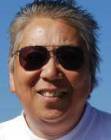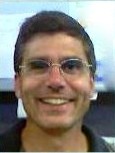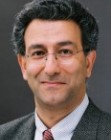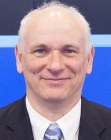|
| |
|
If you
have any questions or need more information, please contact:
SoC@SavantCompany.com
or
949-851-1714 ― Thank
you!
|
|
a
|
Directions &
Parking for Calit2 Building at the University of California, Irvine (UCI)
For questions regarding the SoC Conference
Keynotes, Presentations, and Panelists opportunities, as well as
Sponsorship & Tabletop Exhibit opportunities, please contact:
SoC@SoCconference.com or
949-851-1714
|
|
Nokia
Keynote

|
 Dr.
John Paul Shen, Nokia Fellow, Founding Head of Nokia Research North America
Lab. Dr.
John Paul Shen, Nokia Fellow, Founding Head of Nokia Research North America
Lab.
Keynote: “Mobile Computing Mega Trends and Major Challenges.”
Bio: John P. Shen is a Nokia
Fellow (7th in the company) and was the founding director of Nokia Research
Center - North America Lab (formerly NRC Palo Alto) with research teams
pursuing a very wide range of research projects in mobility and mobile
computing. Prior to joining Nokia in 2006, John was the Director of the
Microarchitecture Research Lab at Intel. Prior to joining Intel in 2000,
John was a tenured Full Professor in the Electrical and Computer Engineering
Department at Carnegie Mellon University, where he supervised a total of 17
PhD students and dozens of MS students, received multiple teaching awards,
and published two books and more than 100 research papers. One of his books,
“Modern Processor Design: Fundamentals of Superscalar Processors”
(McGraw-Hill 2005) is still being used in the EE382 Advanced Processor
Architecture course at Stanford University. He is currently an adjunct
professor at the CMU Silicon Valley campus.
Abstract: This talk highlights
four mega trends for mobile computing and the associated challenges. (1)
Mobility Dominates: mobile devices will be the technology and innovation
driver; (2) Wireless Clouds: the dominant edge of the cloud will become
wireless; (3) Big Data Curating: inundation of massive amounts of real-time
mobile data; (4) Energy Efficiency: improving the ratio of {UserExperience/(EnergyxCost)}
becomes the new scaling law of 2X every 2 years.
|
|
|
|
Microsemi
Keynote

|
 Jim
Aralis, Chief Technology Officer (CTO), and Vice President of R&D. Jim
Aralis, Chief Technology Officer (CTO), and Vice President of R&D.
Keynote: "Living on the Edge (of the SoC)."
Abstract: This
presentation will outline the new process, processor, and packaging
technologies that are enabling the expansion of mixed-signal SoC product
development efforts. Subjects that will be covered include the optimization
of design methodologies, mode partitioning, and process selection to
maximize cost-savings, performance, and time-to-market. The presenter will
also discuss how expertise in analog processing, signal conditioning,
precision timing, and high speed wired and wireless communications design
remain critical for designing differentiated products in an expanding and
evolving digital environment.
Bio: Jim Aralis has served as
chief technology officer and vice president of R&D for Microsemi since
January 2007. He has more than 30 years experience in developing custom
analog device and process technologies, analog and mixed-signal ICs and
systems, and CAD systems. Jim played a key role in transitioning Microsemi to a virtually fabless
model, supporting multiple process technologies including, high voltage and
high power BCD/CMOS, high power high integration CMOS, GaAs, SiGe, IPD, RF
CMOS SoI, GaN, SiC, and several high-density packaging technologies.
From 2000 to 2007, Jim established and served as senior design director of
Maxim Integrated Product’s engineering center in Irvine, Calif. Before that,
he spent 7 years with Texas Instruments/ Silicon Systems as mixed-signal
design head and senior principal engineer. Additional experience includes 11
years with Hughes Aircraft Company in positions of increasing responsibility
including senior scientist. Jim earned a bachelor of science degree in
Math Applied Science and Physics and a master of science in electrical
engineering from UCLA. He holds 9 patents for circuit and system design. |
|
|
|
Intel
 |
 Dr.
Jeff Parkhurst, Program Director, Intel Science and Technology Centers. Dr.
Jeff Parkhurst, Program Director, Intel Science and Technology Centers.
SoC Platform Opportunities and Challenges in the Big Data Economy.”
Abstract: Processing Big Data has been traditionally done at the Cloud
Level. However, the paradigm is shifting as the need to both mine and
process Big Data at the edge becomes paramount. This talk will explore a new
Big Data ecosystem and discuss how it intersects with current SoC platforms
including exploring future opportunities and challenges.
Bio: Dr. Jeff Parkhurst is the Program Director for three Intel Science and
Technology Centers focusing on Embedded Computing, Cloud Computing and Big
Data. He is responsible for managing the operational details in each center
as well as aiding in direction setting of the research. The Program Director
is the primary liaison between Intel and the universities on all operational
matters including contracts, IP, space, logistics, funding, and
technology/knowledge transfer. Prior to this assignment, Jeff was an
Academic Research Programs Manager working with senior technologists
internal and external to Intel setting research directions for the design
science areas of the Semiconductor Research Corporation (SRC). Jeff received
his BS from University of Nevada at Reno in 1983 and his MS from the
University of California at Davis in 1988 and his PhD at Purdue University
in 1994. Dr. Parkhurst is the author of numerous papers and one patent.
|
|
|
|
University of Pennsylvania
Keynote

|
 Dr.
Nader Engheta, H. Nedwill Ramsey Professor of Electrical and Systems
Engineering. Dr.
Nader Engheta, H. Nedwill Ramsey Professor of Electrical and Systems
Engineering.
"Seeing the Unseen: From
polarization-sensitive eyes in nature to system-on-chip sensing and imaging
devices."
Abstract:
Certain animal species in nature have visual systems that are sensitive to
light’s polarization – a capability that is lacking in the human eyes. The
species with polarization vision can detect this characteristic of
image-forming light and can extract its information. Polarization is
obviously an important feature of optical signals, and can be affected by
surface shapes, materials, local curvature, and relative location of sources
and objects, and thus it can provide useful information about the observed
scene and objects. What can one learn from this interesting ability of
polarization sensing and detection in nature that has been evolved in
certain biological visual systems? Understanding the biophysical mechanism
behind the polarization vision and reverse engineering its functionality
leads to exciting novel methods and techniques in sensing and imaging with
various applications. Inspired by the features of polarization-sensitive
visual systems in nature, we have been developing various man-made,
non-invasive imaging methodologies, sensing schemes and visualization and
display schemes that have shown exciting and promising outcomes with useful
applications in system design in the optical and microwave domains. These
techniques provide better target detection, enhanced visibility in otherwise
low-contrast conditions, longer detection range in scattering media,
polarization-sensitive adaptation based on changing environments, surface
deformation-variation detection, “seeing” objects in shadows, and other
novel outcomes and applications. In this talk, I will discuss several
optical aspects of the biophysical mechanisms of polarization vision, and
present sample results of our bio-inspired imaging methodologies. (In
collaboration with Professor Jan Van der Spiegel’s group at UPenn.)
Bio: Recipient of 2013 SINA Award in Engineering and 2012 IEEE
Electromagnetics Award, Nader Engheta is the H. Nedwill Ramsey Professor at
the University of Pennsylvania with affiliations in the Departments of
Electrical and Systems Engineering, Bioengineering, Physics and Astronomy,
and Materials Science and Engineering. He received his B.S. degree from the
University of Tehran, and his M.S and Ph.D. degrees from Caltech. Selected
as one of the Scientific American Magazine 50 Leaders in Science and
Technology in 2006 for developing the concept of optical lumped nanocircuits,
he is a Guggenheim Fellow, an IEEE Third Millennium Medalist, a Fellow of
IEEE, American Physical Society (APS), Optical Society of America (OSA),
American Association for the Advancement of Science (AAAS), and SPIE-The
International Society for Optical Engineering, and the recipient of 2013
Benjamin Franklin Key Award, 2008 George H. Heilmeier Award for Excellence
in Research, the Fulbright Naples Chair Award, NSF Presidential Young
Investigator award, the UPS Foundation Distinguished Educator term Chair,
and several teaching awards including the Christian F. and Mary R. Lindback
Foundation Award, S. Reid Warren, Jr. Award and W. M. Keck Foundation Award.
His current research activities span a broad range of areas including
metamaterials, nanophotonics, graphene optics, imaging and sensing inspired
by eyes of animal species, optical nanoengineering, microwave and optical
antennas, fractional operators in physics, and engineering and physics of
fields and waves. He has co-edited the book entitled “Metamaterials: Physics
and Engineering Explorations” by Wiley-IEEE Press, 2006. He was the Chair of
the Gordon Research Conference on Plasmonics in June 2012. |
|
|
|
Xilinx, Inc.
Keynote

|
 Dr.
Kees Vissers, Distinguished Engineer. Dr.
Kees Vissers, Distinguished Engineer.
Keynote: “The
future of Programming the Zynq SoC platform."
Abstract: In this keynote we
will introduce the Zynq architecture, and we will show that this is ideally
suited to program this architecture to become your own SoC. We will show the
system architecture, the programming environment and the direction of next
generation tools. We will illustrate how this is programmed starting with an
algorithm in OpenCV. We will show an edge detection based motion detection
application that is indicative for the workloads of embedded vision
applications. We will show the mapping on the Zynq processor + FPGA fabric,
and will show the performance in the range of 1 fps on Intel processors with
OpenCV libraries, in the range of one frame per several seconds on the ARM
processors, and a full 1080P 60fps for the implementation on the FPGA. We
will show the measured low power consumption of the total system.
Bio:
Kees
Vissers graduated from Delft University in the Netherlands. He worked at
Philips Research in Eindhoven, the Netherlands, for many years. The work
included Digital Video system design, HW –SW co-design, VLIW processor
design and dedicated video processors. He was a visiting industrial fellow
at Carnegie Mellon University, where he worked on early High Level Synthesis
tools. He was a visiting industrial fellow at UC Berkeley where he worked on
several models of computation and dataflow computing. He was a director of
architecture at Trimedia, and CTO at Chameleon Systems. Today he is heading
a small team of researchers at Xilinx. The research topics include next
generation programming environments for processors and FPGA fabric,
high-performance video systems, wireless applications and new datacenter
applications.
|
|
|
|
|
|
|
|
Selected
Technology
&
Media
Sponsors |
|
* * * * * * *
Back To The Main SoC
Conference Page
Copyright © 2003-2013 by Savant Company Inc. All
Worldwide Rights Reserved.
Wafer images courtesy of Intel Corporation, Micron Technologies & Altera Corporation.
| |
|